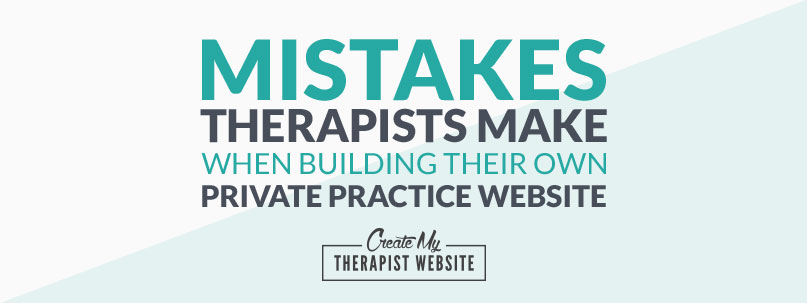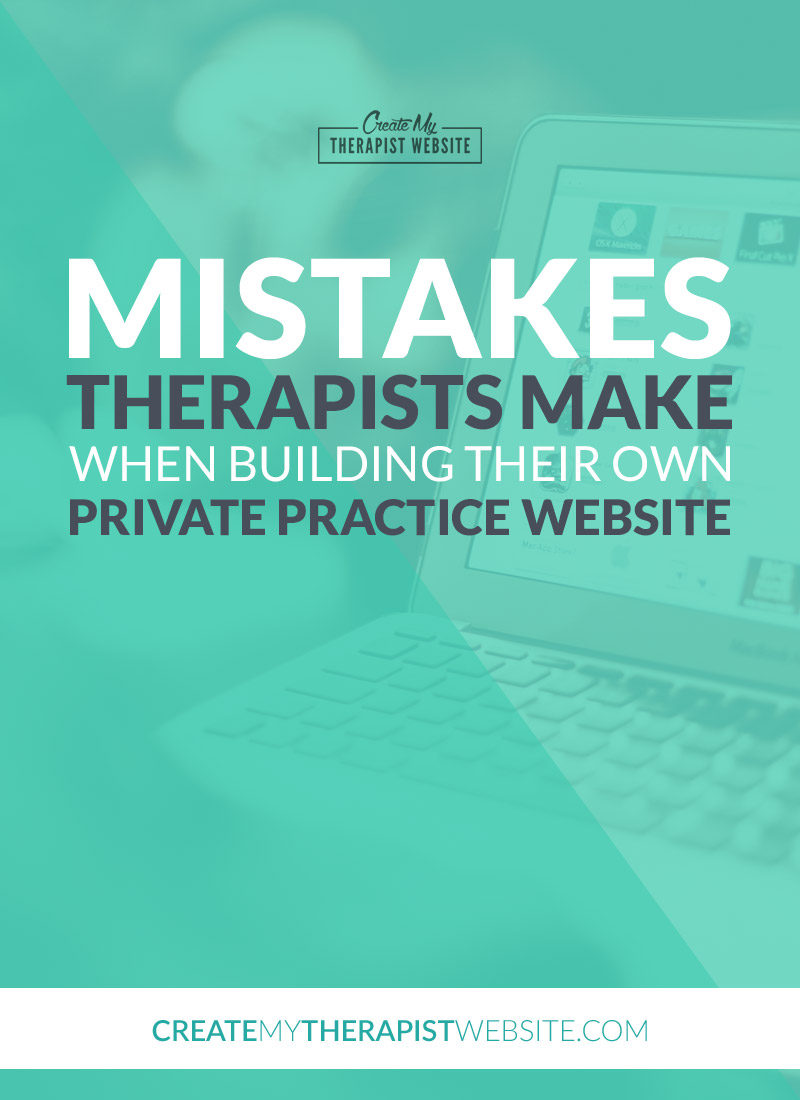As a web designer who’s been in the field since 2001, I can usually spot a DIY therapy website. Not because they’re terrible, but because they lack a few crucial elements that often comes from understanding some basic web design principles.
In this post I’ll discuss some of the common mistakes I see therapists make when they create their own private practice websites to help you avoid the same pitfalls with your own.
Forgetting Calls to Action
Every single piece of content on that therapy website of yours should have a purpose.
You may want to entice folks to call you for a consultation or schedule an appointment. Or perhaps you want to foster community and interact with your audience.
When creating web pages or writing blog posts, I always find it helpful to begin with the end goal in mind. This will help frame the content and lead the reader on a journey to that end.
And the way we lead website visitors is through calls to action; asking them to do something.
Presenting the reader with a call to action allows you to frame the next choice they make. When a user gets to the end of a blog post and there’s nothing for them to do, their choice is to either click through to another page on your website or, more than likely, leave all together.
Do all you can to present them with a choice that will serve your ideal client and let them further interact with you.
Too Many Calls to Action
Have you ever tried searching for something on Google and clicked on a link only to have no idea what to do when you land on the website?
They want you to download an ebook. BUT check out their blog! BUT sign up for this newsletter! BUT learn about this new awesome thing I posted about!
On and on it goes.
Sometimes (and I’m guilty of this too) we ask too much of the users of our websites.
Going back to the mistake mentioned above, each page should have a specific function with a specific call to action. I think it’s ok to have a few links to other content, but as far as ASKING your readers to do something, stick to one thing.
Giving the reader too many options runs the risk that they will choose NONE of those options and leave your website altogether.
Try making your message clear and give them one thing to do. Create dedicated pages or blog posts for the services you have, to give context, so that the reader understands the benefits of what you are offering them.
Then ask them to sign up, download, comment, etc.
A Weak About Page
When I first began seriously blogging, I read tons of blogs and listened to podcast after podcast on online marketing. I wanted to know every single tip I could find about making my blog great.
Time after time I’d hear people say stuff like “make your about page epic”.
I didnt believe the big-shot online marketers at first, so I checked my Google Analytics. Sure enough, the about page was the second most visited page on my website.
This means that the majority of people landing on your site want to know about you before they do anything with you.
This also means that you want to do your best to capture the attention of your potential clients on this page.
So, what’s the biggest piece of advice that I can give on the topic of about pages?
Your about page is not about you.
Let me explain.
Your about page isn’t entirely about you. This page is still about your potential client. They are the reason you have a therapy website in the first place, right?
Once I started imagining my ideal client and the people that I really wanted to help the most, writing this page came so much easier and my message became so much clearer.
This page was no longer just a bio of my life and accomplishments, but a story of how my experiences have equipped me to help therapists in private practice create websites and solve the problems they’re facing with online marketing.
So take some time and evaluate your about page.
Are you speaking directly to your ideal client and letting them know you understand the problems they’re facing?
Do a little research of other about pages out there, both therapists and non-therapists alike, to get ideas for your own.
I highly recommend Nicole Bonsol’s FREE course all about about pages.
Not Creating Specific Pages for Your Therapy Specialties
While it’s great to have one landing page for the services you provide, going deeper into the topics you focus on as a therapist by creating specific pages for each has some great benefits.
The first benefit is to provide information to potential clients and showcase your own expertise and approach to the services you provide.
You can get laser focused and talk to a potential client who is in a very specific place, such as going through a divorce.
The other reason I recommend a page for each of your counseling services or specialties is for the SEO (search engine optimization) benefit.
Having a specific page devoted to a topic (or keyword… see where I’m going here?) is the best way to optimize for search engines.
If someone is searching for help with “grief counseling in Atlanta”, and you’ve got an entire content-rich page devoted to the topic, Google is going to like that.
Take a look at the services you offer and the topics you love to help your clients with. Go ahead and create landing pages or blog posts focused on those topics.
Use on-page SEO to optimize these pages, doing things like:
- Placing the focus keyword in your page title
- Making sure the keyword appears toward the front of the page title
- Making sure the header of your page is in an <h1> tag and includes your keyword
- Making sure the focus keyword appears a few times throughout the page with one instance being within the first or second paragraph
- Making sure the content is 800 – 1500 words in length
- Use the keyword in the page’s URL
- Including images
By creating these specialty pages you are providing more detailed information to potential clients, assuring them that your therapy services can provide the change their looking for.
Not Using Responsive Design
Responsive design refers to the way your website appears across all types of devices.
It means that if someone views your website on a smart phone or a desktop computer, it still looks good and is easy to navigate.
If your website is responsive, it ensures that, no matter what, users will be able to easily use your website and read your information. It would be a shame if you could truly help someone, but they gave up on your website because they couldn’t read it on their phone.
Another reason to make sure your website is responsive is that Google now considers mobile-friendliness as a ranking signal in search results. So if you want to increase your chances of being found, make sure your website is responsive.
The good news is that responsive design is pretty much the standard with the latest services and themes.
So, if your website isn’t responsive, and is due for an upgrade, consider going with a premium WordPress theme, using a service like Wix or Squarespace, or working with a designer on a custom website.
For examples of some great themes, check out my roundup of WordPress themes for therapists and counselors.
Not Thinking of a Potential Client
When it comes to creating therapy websites, I often encourage my clients to envision their ideal client and place themselves in their position.
Finding the right therapist can be a difficult decision, one that’s filled with anxiety and unknowns.
Your website may be one of the very first interactions you’ll have with a client, so it’s important to be there for them and make them comfortable with you as their potential therapist as well as the therapy process in general.
You can do this in a variety of ways:
- Speak in the first person and let your personality come through, not being afraid to be yourself
- Use a professional headshot or shoot a short video to include on your about page
- Create a page for “Your First Visit” and include pictures of your counseling office
- Include frequently asked questions to help potential clients understand the process of working with you
Using empathy, you can fill your website with the exact information that your ideal client needs to find before they feel comfortable enough to step foot in your office.
For mor tips on on designing a therapy website with your clients in mind, check out this post here.
Conclusion
I hope you found this post helpful and you found some tips you could use to improve your own therapy website. By keeping your ideal client in mind, you’ll be able to avoid many of these mistakes, speak to their needs and have a truly effective website.
[av_sidebar widget_area=’Blog Post Resource Library Opt In’ av_uid=’av-2e81ip’]



